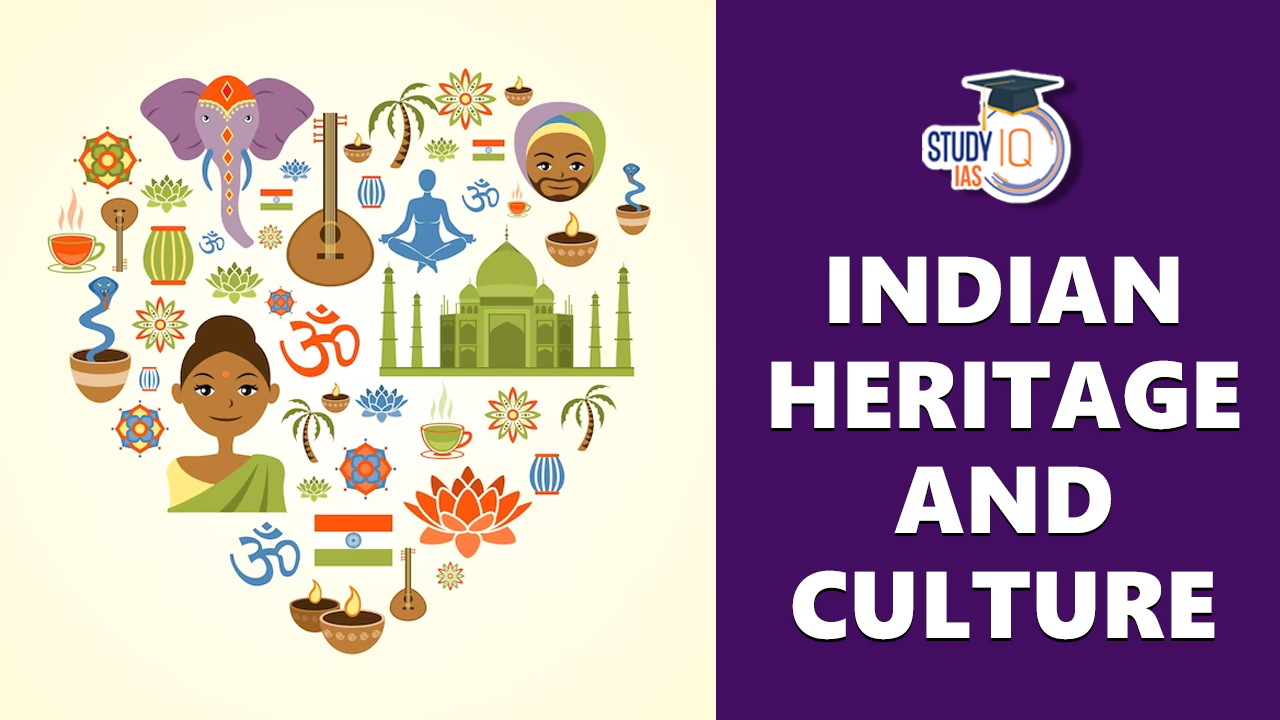Table of Contents
Indian Culture and Heritage
Indian culture and heritage is the amalgam of social mores, moral principles, age-old customs, religious beliefs, political ideologies, artifacts, and technological advancements that have their origins in or are connected to the ethnolinguistically diverse Indian subcontinent. India is a nation with a varied cultural heritage. India’s culture is made up of a variety of tiny, independent civilizations. Indian culture includes a variety of elements including costumes, holidays, dialects, religions, music, dance, architecture, cuisine, and art. Check the detailed information on Indian Culture and Heritage below in this article.
Indian Culture
Most significantly, throughout its history, Indian culture has been influenced by many foreign cultures. The history of Indian culture also goes back thousands of years. Religions include Jainism, Sikhism, Buddhism, and Hinduism. All of these faiths are based on karma and dharma. These four are referred to as Indian religions. Indian religions are a significant group of world religions, along with Abrahamic religions.
In addition, India is home to many other foreign religions. These alien religions include the Abrahamic faiths. The Abrahamic religions are without a doubt Judaism, Christianity, and Islam in India. Along with Abrahamic religions, Zoroastrianism and the Bahá’ Faith are also practiced in India. Given the diversity of its population, Indian society has embraced tolerance and secularism.
The blended family structure is prevalent in Indian culture. Parents, kids, kids’ spouses, and children’s children are the most notable family members. The entire family resides together. In addition, the family is headed by the oldest male member. In Indian culture, pre-planned unions are typical. The majority of Indian weddings are almost certainly organized by the parents. Indian marriages almost universally include dowries from the bride’s family. In Indian culture, weddings are unquestionably happy occasions. Indian weddings feature striking decorations, attire, music, dancing, and traditions. Most notably, India has relatively low divorce rates.
About Indian Culture
India’s civilization dates back over 4,500 years, making Indian culture one of the oldest in the world. The All World Gayatri Pariwar (AWGP) group refers to it as “Sa Prathama Sanskrati Vishvavara” — the first and the greatest culture in the world.
Christina De Rossi, an anthropologist at Barnet and Southgate College in London, claimed that Western countries did not always see Indian culture favorably. Culture was formerly thought to be an evolutionary process by early anthropologists, and “every aspect of human development was seen as driven by evolution,” she told Live Science. “According to this perspective, societies that were not based in Europe or North America or that did not adhere to a Western or European way of life were viewed as being primitive and culturally inferior.
Language
The World Health Organization estimates that India has 28 states and 7 territories. According to a Gujarat High Court decision from 2010, Hindi is the official language of the government, although there isn’t an official language in India. 23 official languages are recognized by the Indian Constitution.
Devanagari script is widely used by Indian writers. In actuality, it is a myth that Hindi is the language of choice in India. Despite the fact that many people in India speak Hindi, according to The Times of India, 59 percent of people in India speak a language other than Hindi. Other languages spoken in the nation include Bengali, Telugu, Marathi, Tamil, and Urdu.
Northern India is where Sanskrit, an old Indo-European language, originated. It is frequently used in action movies. Linguists disagree on the exact beginning of the language. It has numerous similarities to the languages of English, French, Farsi, and Russian. Sanskrit’s origins may have been brought about by an Aryan invasion, according to recent DNA research published in 2017. According to Martin Richards, an archaeogeneticist at the University of Huddersfield in England and research co-author, “people have been debating the arrival of the Indo-European languages in India for hundreds of years.” The question of whether the Indo-European languages originated locally rather than being introduced by outside migrations, which is what most linguists would believe, has been debated for a very long time. [India’s Bronze-Age Population May Have Changed Due to the Aryan Invasion]
Religion
The third- and fourth-largest religions, Hinduism and Buddhism, are said to have originated in India. The “Handbook of Research on Development and Religion,” edited by Matthew Clarke (Edward Elgar Publishing, 2013), estimates that 84 percent of the population identifies as Hindu. Hinduism is a diverse religion with four main sects: Shaiva, Vaishnava, Shakteya, and Smarta.
One of the major Islamic countries in the world, India has about 13 percent of its population as Muslims. According to the “Handbook,” there are not many Christians or Sikhs in India, and much fewer Buddhists and Jains.
Architecture and art
The Taj Mahal, which was erected by Mughal emperor Shah Jahan in memory of his third wife, Mumtaz Mahal, is the most well-known example of Indian architecture. It incorporates features from the architectural styles of Islam, Persia, the Ottoman Turkish Empire, and India. India is home to numerous historic temples.
Bollywood, the name given to India’s film industry, is well-known worldwide. According to the Golden Globes, the country’s film history began in 1896 when the Lumière brothers presented a demonstration of the cinematic medium in Mumbai. The extravagant singing and dancing in the movies has made them famous today.
Nilima Bhadbhade, author of “Contract Law in India” (Kluwer Law International, 2010), claims that Indian dance, music, and theater traditions date back more than 2,000 years. The two main classical dance genres are Kathak and Bharata Natyam Odissi, Manipuri, Kuchipudi, Mohiniattam and Kathakali — draw on themes from mythology and literature and have rigid presentation rules.
According to a study that was published in the Journal of Indian Ocean Archaeology in April 2016, some Indian horns are very similar to Irish horns. According to this research, the two nations may have shared concepts and methods for creating musical instruments during the Bronze Age. Billy Foghl, an archaeologist and PhD student at the Australian National University in Canberra and one of the study’s authors, told Live Science that some horns are “honestly shockingly similar, to the point where it is like witnessing time travel.” “I would probably assume it was a Late Bronze Age Irish artifact if I were to find one of these modern Indian instruments in an Irish archaeological excavation and I didn’t know what I was looking at.”
Food
According to Texas A&M University, the Mughal Empire’s invasion during the sixteenth century made a lasting impression on Indian food. Many other nations have affected Indian food as well. It is renowned for having a wide variety of dishes and for using lots of herbs and spices. Different regions have different cooking methods.
The three main components of the Indian cuisine are wheat, basmati rice, and pulses like chana (Bengal gram). Curries and spices, such as ginger, coriander, cardamom, turmeric, dried spicy peppers, and cinnamon, are abundant in the dish. Indian cuisine makes extensive use of chutneys, which are thick condiments and spreads created from a variety of fruits, vegetables, and herbs including mint, cilantro, and cilantro.
Lamb and chicken are frequently found in main courses for non-vegetarians even though many Hindus are vegetarians. According to The Guardian, between 20 and 40 percent of Indians identify as vegetarians. Indian cuisine is frequently consumed with bread or fingers as utensils. Naan, a leavened, oven-baked flatbread, and bhatoora, a fried, fluffy flatbread popular in North India and eaten with chickpea stew, are just a couple of the many breads that are offered with meals.
Customs and celebrations
According to National Geographic, the biggest and most significant holiday in India is Diwali. The five-day celebration is referred to as the “festival of lights” because candles are lit to represent the inner light that shields participants from spiritual gloom. The springtime celebration of Holi, also known as the festival of love, is well-known. Along with Republic Day and Independence Day, the nation also observes Mahatma Gandhi’s birthday on October 2 and Republic Day on January 26.
Clothing
The vibrant silk saris donned by many Indian ladies are a key component of the country’s fashion identity. The dhoti, an unstitched garment that is tied around the waist and legs of males, is a traditional article of clothing. Men also dress in loose kurtas, which are worn to the knee. Men typically dress in a sherwani or achkan, a long coat with no lapels on the collar, for important events. It is knee-length and fully buttoned up to the collar. The term “Nehru jacket” refers to a sherwani that is less long. Although Jawaharlal Nehru served as prime minister of India from 1947 to 1964, he never wore a Nehru jacket. According to the Indian newspaper Tehelka, he preferred the achkan. Westerners were the target market for the Nehru jacket.
Indian Heritage
What we inherit from our mothers and fathers is referred to as our heritage. India has a wide variety of cultures and traditions. People of different castes, beliefs, and creeds live in our country. Every ethnic group in our nation has a unique origin story, as well as a unique collection of customs and cultural practices. Each of them has left a unique imprint on Indian history and culture. In India, nature has created a unique geographical region.
Our nation is home to many different religious communities, contributing to the rich diversity of our tradition and culture. Every society transmits its own set of customs and rituals to succeeding generations. However, certain of our customs and practices are shared throughout India. Our traditions show us how to form positive habits and improve ourselves. Therefore, our cultural heritage is a priceless gift from our elders that will enable us to improve as individuals and foster peaceful community development.
Constitutional and Legislative Provisions Related to Indian Heritage
The following divisions of authority over monuments, pieces of cultural heritage, and archaeological sites are set down in the Indian Constitution:
- The historical and archaeologically significant monuments and locations that Parliament has designated through legislation.
- Both the Union and States possess concurrent jurisdiction over archaeological sites and remains other than those declared of national importance by law.
- Article 49 of Directive Principle of State Policy requires the State to safeguard any monuments, locations, or items of artistic or historic interest that have been deemed to be of national significance by or pursuant to legislation enacted by Parliament.
- Every Indian citizen has a responsibility to respect and conserve the rich cultural heritage of their country, according to Article 51A of Fundamental Duties in the Indian Constitution.
- The Ancient Monuments and Archaeological Sites and Remains Act (AMASR Act) of 1958 is a law passed by the Indian Parliament that establishes guidelines for the protection of sculptures, carvings, and other similar artifacts as well as the preservation of important historical and archaeological sites and remains.
India’s UNESCO World Natural Heritage Sites
The following geological locations have been named UNESCO World Heritage Sites (Natural). The following websites:
- In 1985, at Kaziranga National Park, home of the endangered one-horned rhinoceros.
- Established in 1985, Keoladeo National Park is home to many species of lovely birds.
- The Manas Wildlife Sanctuary was founded in 1985.
- The world’s largest mangrove forest, Sundarbans, in 1987.
- National Parks of Nanda Devi and the Valley of Flowers, 2004.
- The Western Ghats in 2012.
- The Great Himalayan National Park received the UNESCO World Heritage Site designation in 2014.
Indian Culture and Heritage UPSC
India is a very ancient nation. We are blessed to have such a lovely past. It is entirely our responsibility to protect it so that subsequent generations can see and appreciate it as well. Protecting India’s artistic legacy is essential for maintaining the nation’s identity, history, and culture. It is crucial to take action to save this history so that future generations can value it and be inspired by it.
Other Related Links
| Other Related Links | |
| Sangam Literature | Rig Vedic Literature |
| Later Vedic Literature | Harappan Culture |
| Folk Dance of India | Classical Dance of India |
| Archaeological Survey of India | |


 UPSC CMS Admit Card 2025 Out: Download L...
UPSC CMS Admit Card 2025 Out: Download L...
 UPSC Study Material for Prelims & Ma...
UPSC Study Material for Prelims & Ma...
 NATO Countries List 2025, Members, Funct...
NATO Countries List 2025, Members, Funct...





















